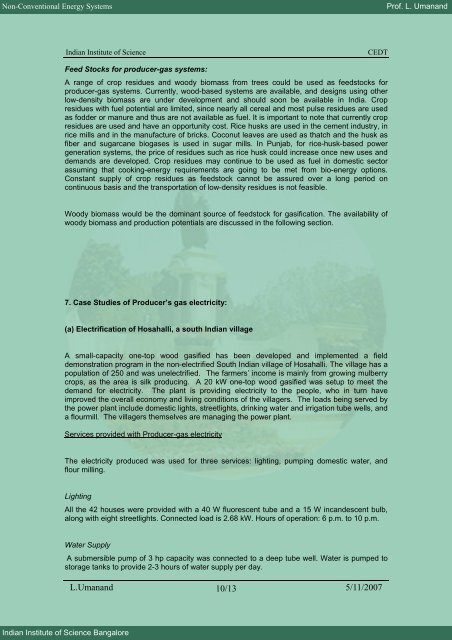Chapter 7 - E-Courses
Chapter 7 - E-Courses
Chapter 7 - E-Courses
You also want an ePaper? Increase the reach of your titles
YUMPU automatically turns print PDFs into web optimized ePapers that Google loves.
Non-Conventional Energy Systems Prof. L. Umanand<br />
Indian Institute of Science Bangalore<br />
Indian Institute of Science CEDT<br />
Feed Stocks for producer-gas systems:<br />
A range of crop residues and woody biomass from trees could be used as feedstocks for<br />
producer-gas systems. Currently, wood-based systems are available, and designs using other<br />
low-density biomass are under development and should soon be available in India. Crop<br />
residues with fuel potential are limited, since nearly all cereal and most pulse residues are used<br />
as fodder or manure and thus are not available as fuel. It is important to note that currently crop<br />
residues are used and have an opportunity cost. Rice husks are used in the cement industry, in<br />
rice mills and in the manufacture of bricks. Coconut leaves are used as thatch and the husk as<br />
fiber and sugarcane biogases is used in sugar mills. In Punjab, for rice-husk-based power<br />
generation systems, the price of residues such as rice husk could increase once new uses and<br />
demands are developed. Crop residues may continue to be used as fuel in domestic sector<br />
assuming that cooking-energy requirements are going to be met from bio-energy options.<br />
Constant supply of crop residues as feedstock cannot be assured over a long period on<br />
continuous basis and the transportation of low-density residues is not feasible.<br />
Woody biomass would be the dominant source of feedstock for gasification. The availability of<br />
woody biomass and production potentials are discussed in the following section.<br />
7. Case Studies of Producer’s gas electricity:<br />
(a) Electrification of Hosahalli, a south Indian village<br />
A small-capacity one-top wood gasified has been developed and implemented a field<br />
demonstration program in the non-electrified South Indian village of Hosahalli. The village has a<br />
population of 250 and was unelectrified. The farmers’ income is mainly from growing mulberry<br />
crops, as the area is silk producing. A 20 kW one-top wood gasified was setup to meet the<br />
demand for electricity. The plant is providing electricity to the people, who in turn have<br />
improved the overall economy and living conditions of the villagers. The loads being served by<br />
the power plant include domestic lights, streetlights, drinking water and irrigation tube wells, and<br />
a flourmill. The villagers themselves are managing the power plant.<br />
Services provided with Producer-gas electricity<br />
The electricity produced was used for three services: lighting, pumping domestic water, and<br />
flour milling.<br />
Lighting<br />
All the 42 houses were provided with a 40 W fluorescent tube and a 15 W incandescent bulb,<br />
along with eight streetlights. Connected load is 2.68 kW. Hours of operation: 6 p.m. to 10 p.m.<br />
Water Supply<br />
A submersible pump of 3 hp capacity was connected to a deep tube well. Water is pumped to<br />
storage tanks to provide 2-3 hours of water supply per day.<br />
L.Umanand 5/11/2007<br />
10/13

















